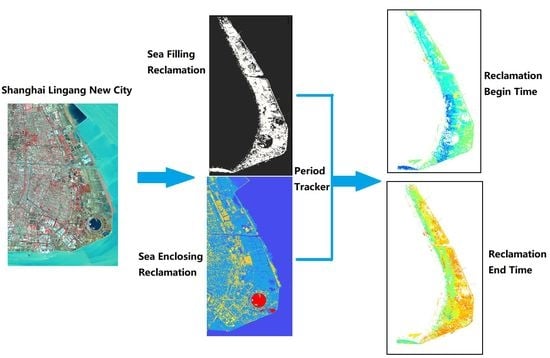Tracking of Land Reclamation Activities Using Landsat Observations—An Example in Shanghai and Hangzhou Bay
Abstract
:1. Introduction
2. Study Area and Dataset
2.1. Study Area
2.2. Study Dataset
2.3. Validation Data
3. Method
3.1. Reclamation Area Locator
- The SEDIMENT area only appears at the coastline.
- The land cover type of the SEDIMENT area changes between water and non-water frequently during the SEDIMENT signal appearance period.
- Two target classification results were selected based on the reclamation detection period requirement.
- The Water class of the classification result in the later image was selected, and the “Eight-Neighborhood” morphological method was used to designate the largest water body in the previous image.
- Two selected water area maps were stacked together. The isolated water area from a later observation in the stacked area was the sea enclosing reclamation area.
3.2. Reclamation Period Tracker
- The frequency of Water does not change before the reclamation period.
- The frequency of Non-water does not change after the reclamation period.
- The frequency of SEDIMENT increases at the beginning of reclamation and decreases at the end of the reclamation.
3.3. Reclamation Tracker Validation
4. Results
4.1. Reclamation Map of Shanghai Lingang New City
4.2. Reclamation Tracker Result of Shanghai Lingang New City
4.3. Reclamation Map of Hangzhou Bay
4.4. Accuracy Assessment
5. Conclusions
Supplementary Materials
Author Contributions
Funding
Institutional Review Board Statement
Informed Consent Statement
Data Availability Statement
Conflicts of Interest
References
- Lunetta, R.S.; Knight, J.F.; Ediriwickrema, J.; Lyon, J.G.; Worthy, L.D. Land-cover change detection using multi-temporal MODIS NDVI data. Remote Sens. Environ. 2006, 105, 142–154. [Google Scholar] [CrossRef]
- Chee, S.Y.; Othman, A.G.; Sim, Y.K.; Adam, A.N.M.; Firth, L. Land reclamation and artificial islands: Walking the tightrope between development and conservation. Glob. Ecol. Conserv. 2017, 12, 80–95. [Google Scholar] [CrossRef] [Green Version]
- Wang, W.; Liu, H.; Li, Y.; Su, J. Development and management of land reclamation in China. Ocean Coast. Manag. 2014, 102, 415–425. [Google Scholar] [CrossRef]
- Hoeksema, R.J. Three stages in the history of land reclamation in the Netherlands. Irrig. Drain. 2007, 56, S113–S126. [Google Scholar] [CrossRef]
- Jia, R.; Lei, H.; Hino, T.; Arulrajah, A. Environmental changes in Ariake Sea of Japan and their relationships with Isahaya Bay reclamation. Mar. Pollut. Bull. 2018, 135, 832–844. [Google Scholar] [CrossRef]
- Lie, H.-J.; Cho, C.-H.; Lee, S.; Kim, E.-S.; Koo, B.-J.; Noh, J.-H. Changes in Marine Environment by a Large Coastal Development of the Saemangeum Reclamation Project in Korea. Ocean Polar Res. 2008, 30, 475–484. [Google Scholar] [CrossRef] [Green Version]
- Lee, C.-H.; Lee, B.-Y.; Chang, W.K.; Hong, S.; Song, S.J.; Park, J.; Kwon, B.-O.; Khim, J.S. Environmental and ecological effects of Lake Shihwa reclamation project in South Korea: A review. Ocean Coast. Manag. 2014, 102, 545–558. [Google Scholar] [CrossRef]
- Slamet, N.S.; Dargusch, P.; Aziz, A.A.; Wadley, D. Mangrove vulnerability and potential carbon stock loss from land reclamation in Jakarta Bay, Indonesia. Ocean Coast. Manag. 2020, 195, 105283. [Google Scholar] [CrossRef]
- Sengupta, D.; Chen, R.; Meadows, M.E. Building beyond land: An overview of coastal land reclamation in 16 global megacities. Appl. Geogr. 2018, 90, 229–238. [Google Scholar] [CrossRef]
- Tian, B.; Wu, W.; Yang, Z.; Zhou, Y. Drivers, trends, and potential impacts of long-term coastal reclamation in China from 1985 to 2010. Estuar. Coast. Shelf Sci. 2016, 170, 83–90. [Google Scholar] [CrossRef]
- Wang, X.; Yan, F.; Su, F. Changes in coastline and coastal reclamation in the three most developed areas of China, 1980–2018. Ocean Coast. Manag. 2021, 204, 105542. [Google Scholar] [CrossRef]
- Ma, Z.; Melville, D.S.; Liu, J.; Chen, Y.; Yang, H.; Ren, W.; Zhang, Z.; Piersma, T.; Li, B. Rethinking China’s new great wall. Science 2014, 346, 912–914. [Google Scholar] [CrossRef] [Green Version]
- Yang, H.-Y.; Chen, B.; Barter, M.; Piersma, T.; Zhou, C.-F.; Li, F.-S.; Zhang, Z.-W. Impacts of tidal land reclamation in Bohai Bay, China: Ongoing losses of critical Yellow Sea waterbird staging and wintering sites. Bird Conserv. Int. 2011, 21, 241–259. [Google Scholar] [CrossRef] [Green Version]
- Hudak, A.T.; Wessman, C.A. Textural Analysis of Historical Aerial Photography to Characterize Woody Plant Encroachment in South African Savanna. Remote Sens. Environ. 1998, 66, 317–330. [Google Scholar] [CrossRef]
- Wang, X.; Liu, Y.; Ling, F.; Liu, Y.; Fang, F. Spatio-Temporal Change Detection of Ningbo Coastline Using Landsat Time-Series Images during 1976–2015. ISPRS Int. J. Geo-Inf. 2017, 6, 68. [Google Scholar] [CrossRef] [Green Version]
- Bouchahma, M.; Yan, W.; Ouessar, M. Island Coastline Change Detection Based on Image Processing and Remote Sensing. Comput. Inf. Sci. 2012, 5, p27. [Google Scholar] [CrossRef] [Green Version]
- Patel, S.; Shah, E.; Jayaprasad, P.; James, M. Changes in Antarctic coastline between 1997 and 2016 using RADARSAT and MODIS data. Int. J. Remote Sens. 2019, 41, 1389–1414. [Google Scholar] [CrossRef]
- Aedla, R.; Dwarakish, G.; Reddy, D.V. Automatic Shoreline Detection and Change Detection Analysis of Netravati-GurpurRivermouth Using Histogram Equalization and Adaptive Thresholding Techniques. Aquat. Procedia 2015, 4, 563–570. [Google Scholar] [CrossRef]
- El-Kawy, O.A.; Rød, J.K.; Ismail, H.; Suliman, A. Land use and land cover change detection in the western Nile delta of Egypt using remote sensing data. Appl. Geogr. 2011, 31, 483–494. [Google Scholar] [CrossRef]
- Sengupta, D.; Chen, R.; Meadows, M.E.; Choi, Y.R.; Banerjee, A.; Zilong, X. Mapping Trajectories of Coastal Land Reclamation in Nine Deltaic Megacities using Google Earth Engine. Remote Sens. 2019, 11, 2621. [Google Scholar] [CrossRef] [Green Version]
- Xu, H.; Chen, L.; Zhao, B.; Zhang, Q.; Cai, Y. Green stormwater infrastructure eco-planning and development on the regional scale: A case study of Shanghai Lingang New City, East China. Front. Earth Sci. 2015, 10, 366–377. [Google Scholar] [CrossRef]
- Xu, N.; Gong, P. Significant coastline changes in China during 1991–2015 tracked by Landsat data. Sci. Bull. 2018, 63, 883–886. [Google Scholar] [CrossRef] [Green Version]
- Kovalskyy, V.; Roy, D. The global availability of Landsat 5 TM and Landsat 7 ETM+ land surface observations and implications for global 30m Landsat data product generation. Remote Sens. Environ. 2013, 130, 280–293. [Google Scholar] [CrossRef] [Green Version]
- Masek, J.; Vermote, E.; Saleous, N.; Wolfe, R.; Hall, F.; Huemmrich, K.; Gao, F.; Kutler, J.; Lim, T.-K. A Landsat Surface Reflectance Dataset for North America, 1990–2000. IEEE Geosci. Remote Sens. Lett. 2006, 3, 68–72. [Google Scholar] [CrossRef]
- Vermote, E.; Justice, C.; Claverie, M.; Franch, B. Preliminary analysis of the performance of the Landsat 8/OLI land surface reflectance product. Remote Sens. Environ. 2016, 185, 46–56. [Google Scholar] [CrossRef]
- Gong, P.; Wang, J.; Yu, L.; Zhao, Y.; Zhao, Y.; Liang, L.; Niu, Z.; Huang, X.; Fu, H.; Liu, S.; et al. Finer resolution observation and monitoring of global land cover: First mapping results with Landsat TM and ETM+ data. Int. J. Remote Sens. 2013, 34, 2607–2654. [Google Scholar] [CrossRef] [Green Version]
- Chen, J.; Chen, J.; Liao, A.; Cao, X.; Chen, L.; Chen, X.; He, C.; Han, G.; Peng, S.; Lu, M.; et al. Global land cover mapping at 30 m resolution: A POK-based operational approach. ISPRS J. Photogramm. Remote Sens. 2011, 103, 7–27. [Google Scholar] [CrossRef] [Green Version]
- Huang, C.; Zhang, C.; Liu, Q.; Wang, Z.; Li, H.; Liu, G. Land reclamation and risk assessment in the coastal zone of China from 2000 to 2010. Reg. Stud. Mar. Sci. 2020, 39, 101422. [Google Scholar] [CrossRef]
- Zhen, L.; Chan, A. An artificial intelligent algorithm for tumor detection in screening mammogram. IEEE Trans. Med. Imaging 2001, 20, 559–567. [Google Scholar] [CrossRef]
- Shi, Y.; Feng, L.; Gong, J. Four decades of the morphological dynamics of the lakes in the Jianghan Plain using Landsat observations. Water Environ. J. 2017, 31, 353–359. [Google Scholar] [CrossRef]
- Dhanachandra, N.; Manglem, K.; Chanu, Y.J. Image Segmentation Using K -means Clustering Algorithm and Subtractive Clustering Algorithm. Procedia Comput. Sci. 2015, 54, 764–771. [Google Scholar] [CrossRef] [Green Version]
- Ossama, O.; Mokhtar, H.M.; El-Sharkawi, M.E. An extended k-means technique for clustering moving objects. Egypt. Inform. J. 2011, 12, 45–51. [Google Scholar] [CrossRef] [Green Version]
- Steinley, D. K-means clustering: A half-century synthesis. Br. J. Math. Stat. Psychol. 2006, 59, 1–34. [Google Scholar] [CrossRef] [PubMed] [Green Version]
- He, C.; Li, X.; Hu, Y.; Ye, Z.; Kang, H. Microscope images automatic focus algorithm based on eight-neighborhood operator and least square planar fitting. Optik 2020, 206, 164232. [Google Scholar] [CrossRef]
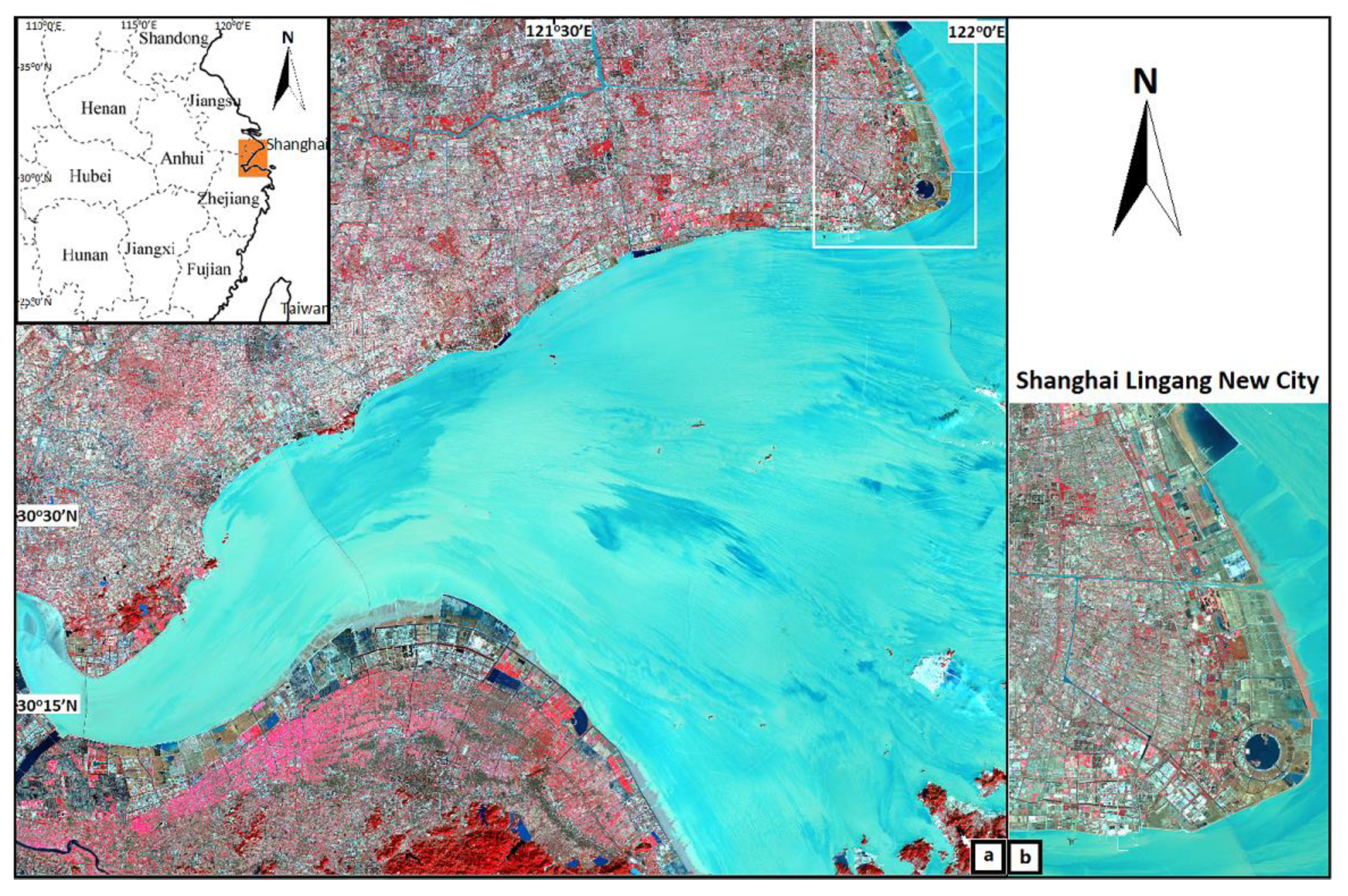

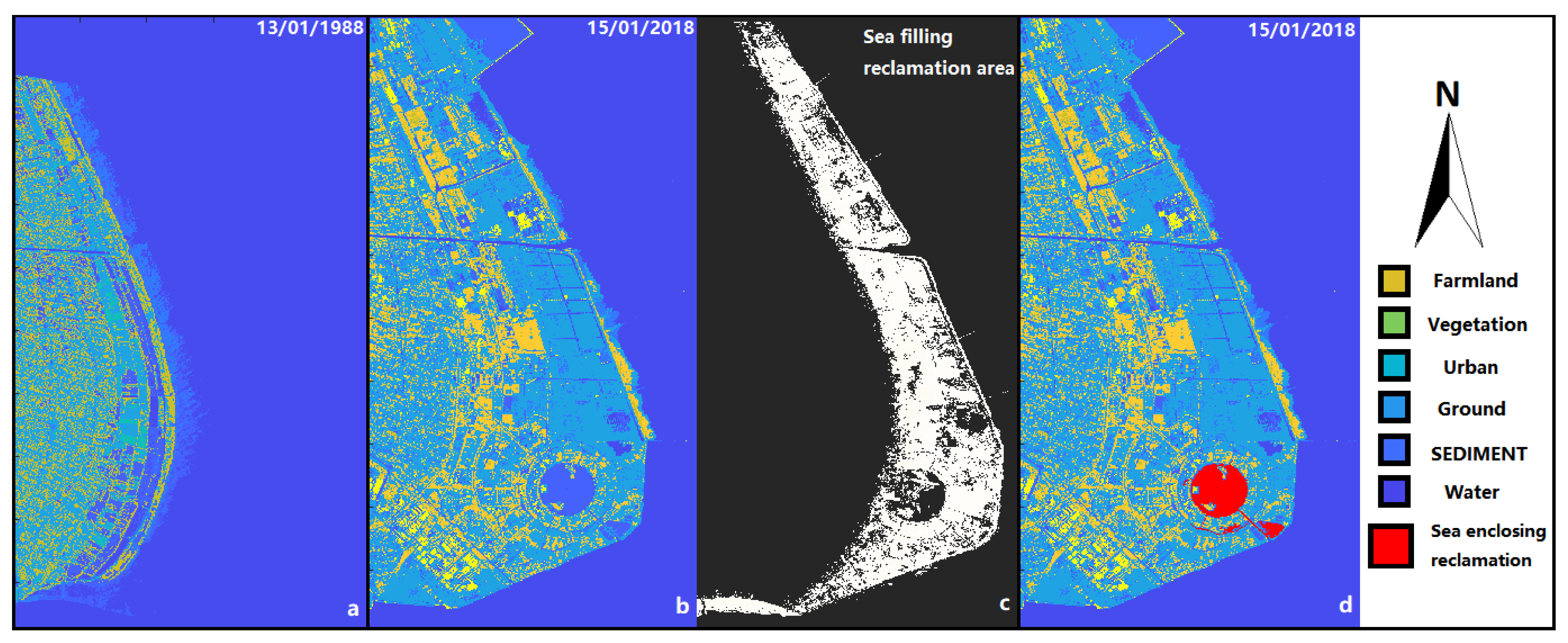
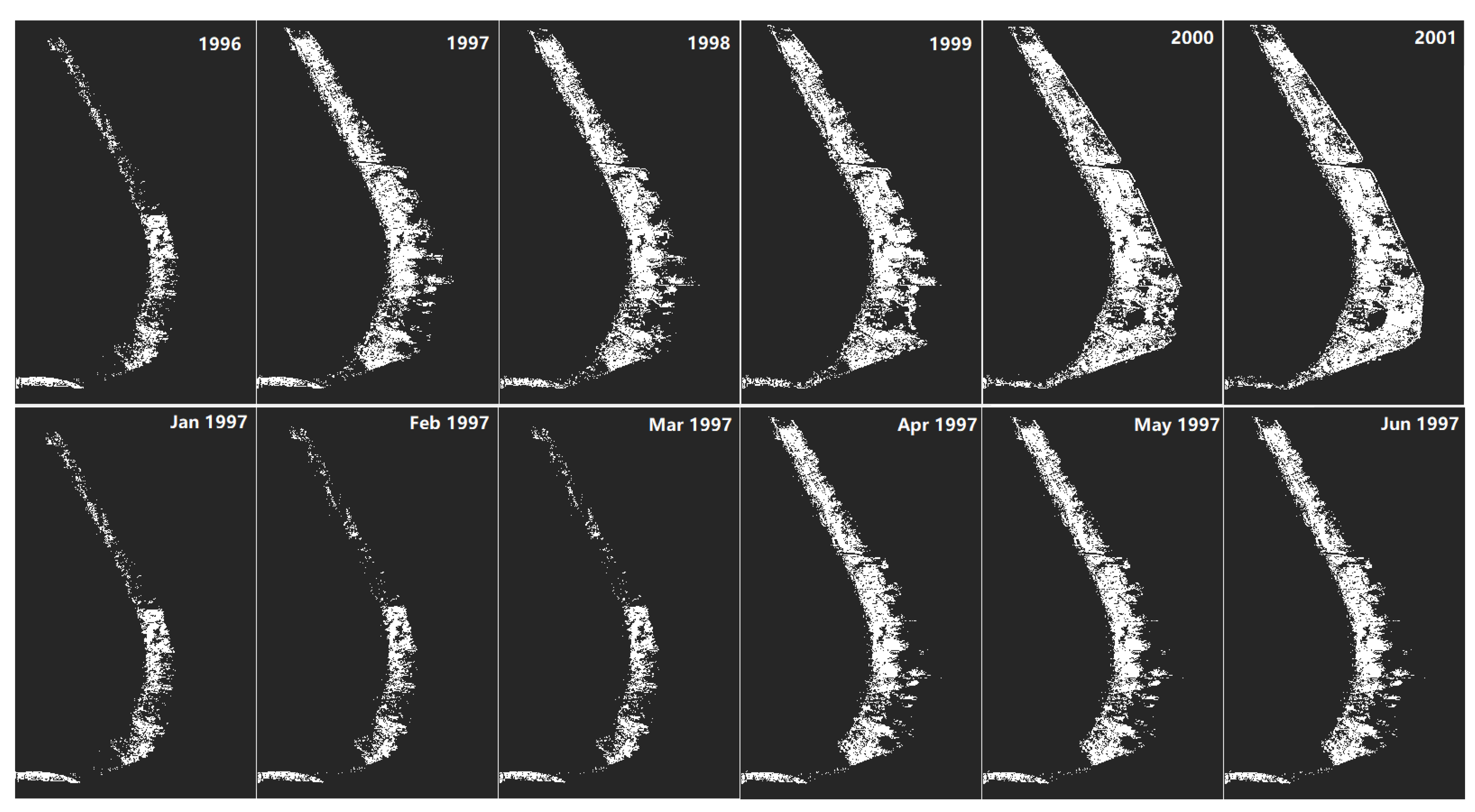
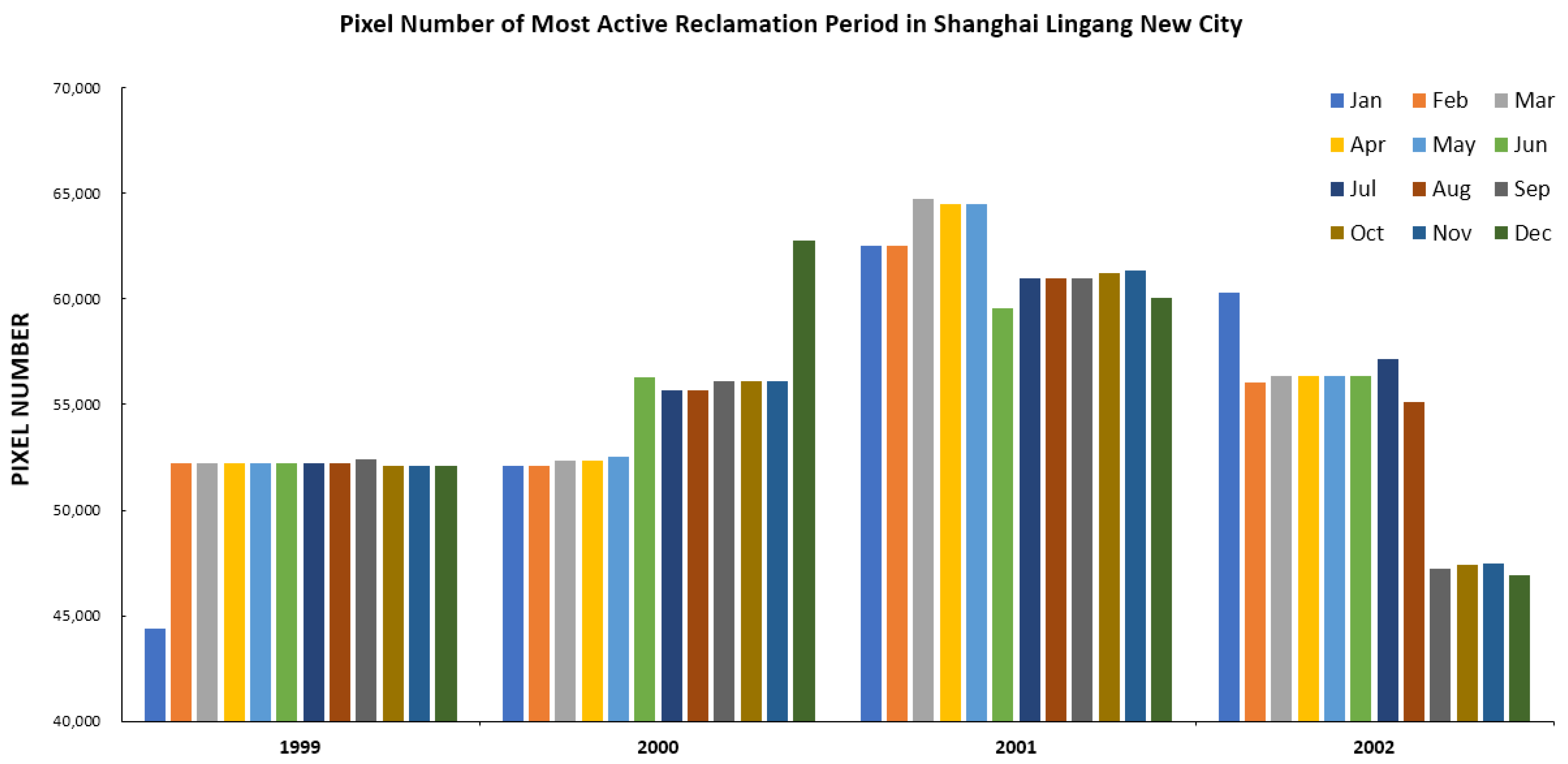
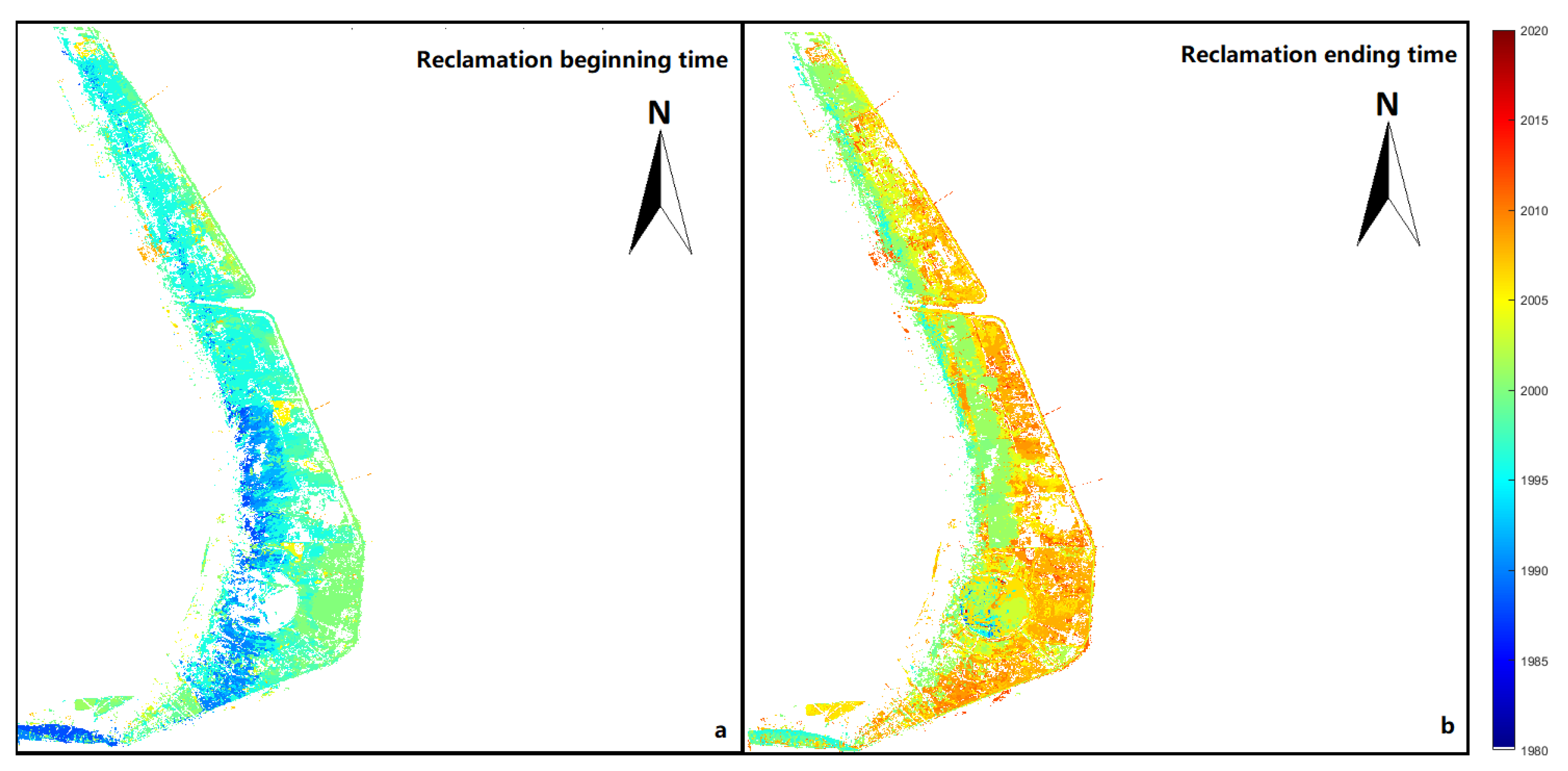
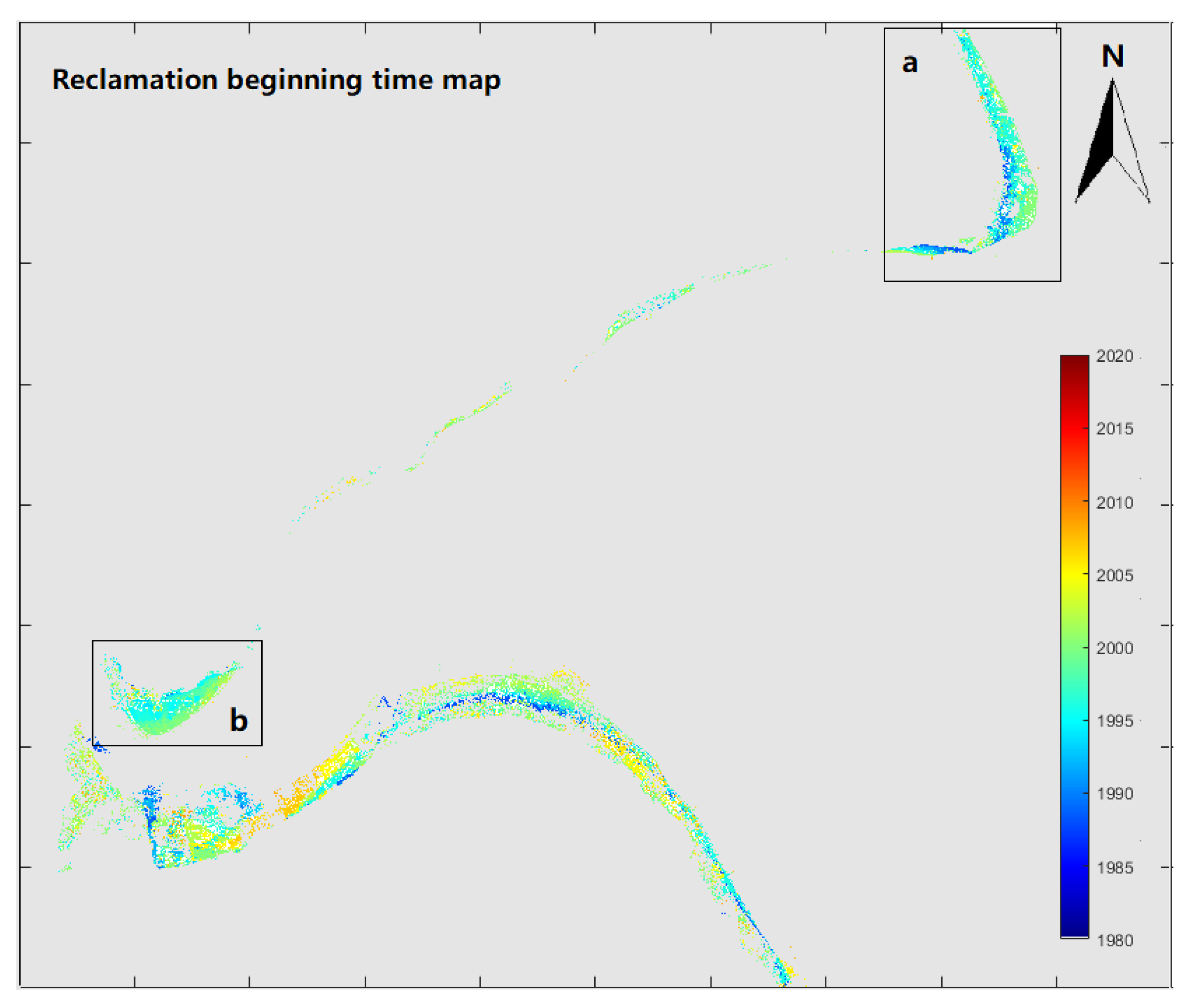
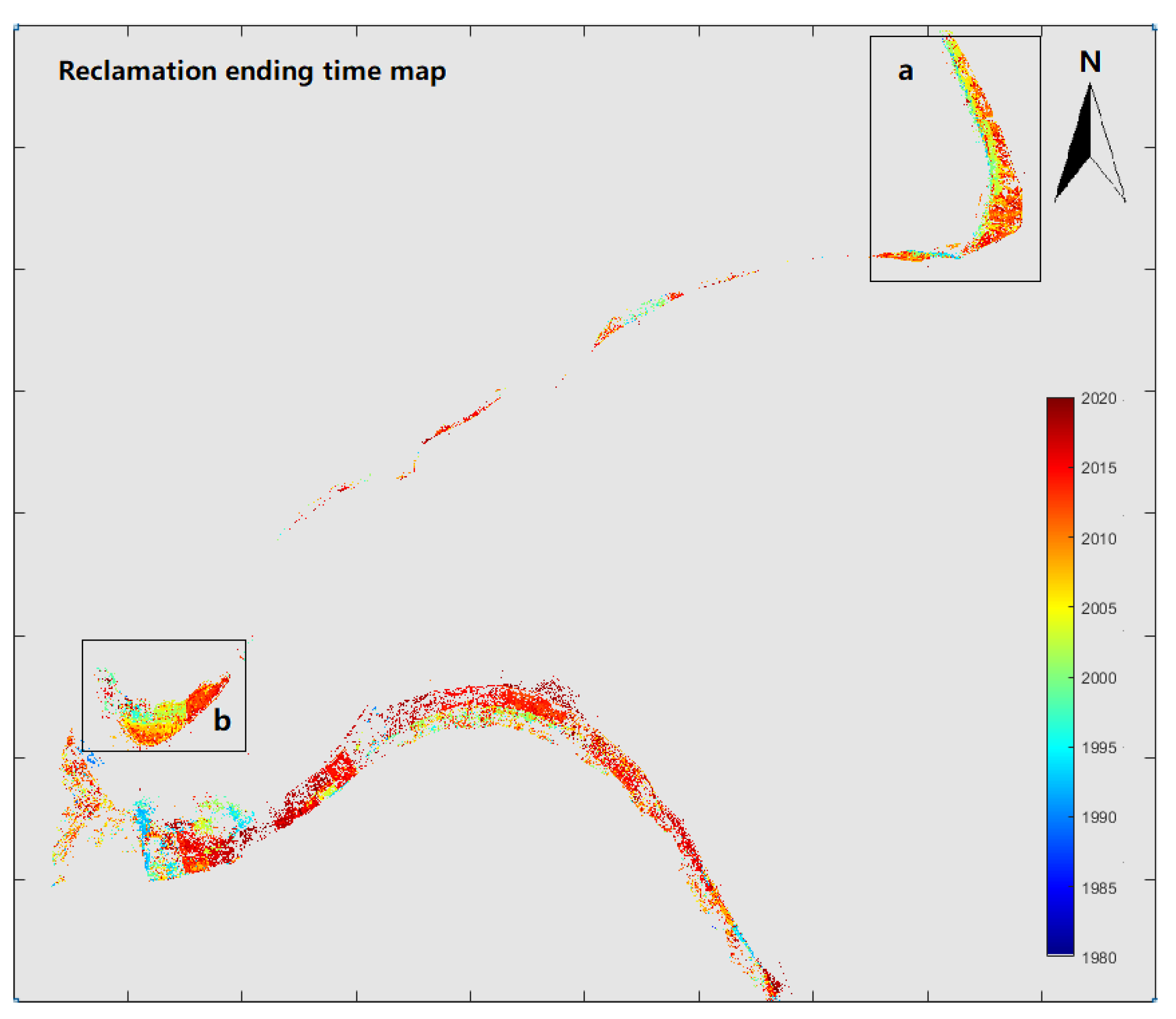
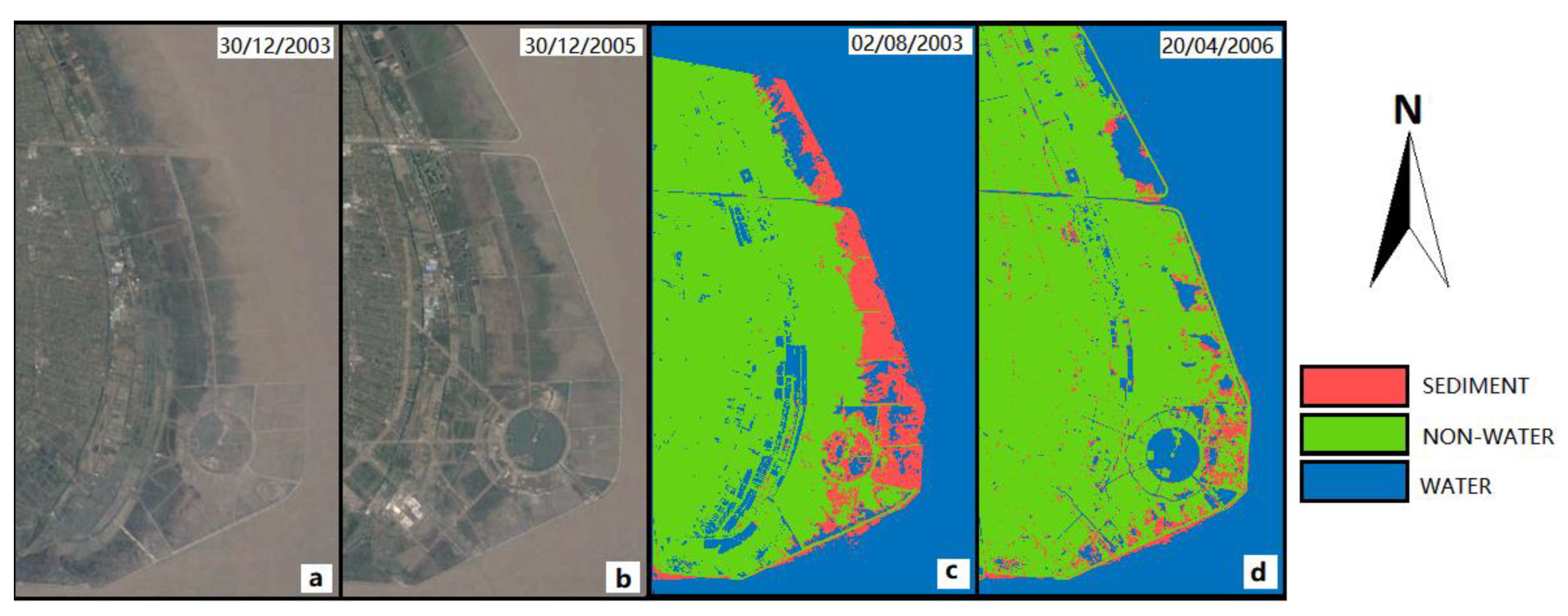
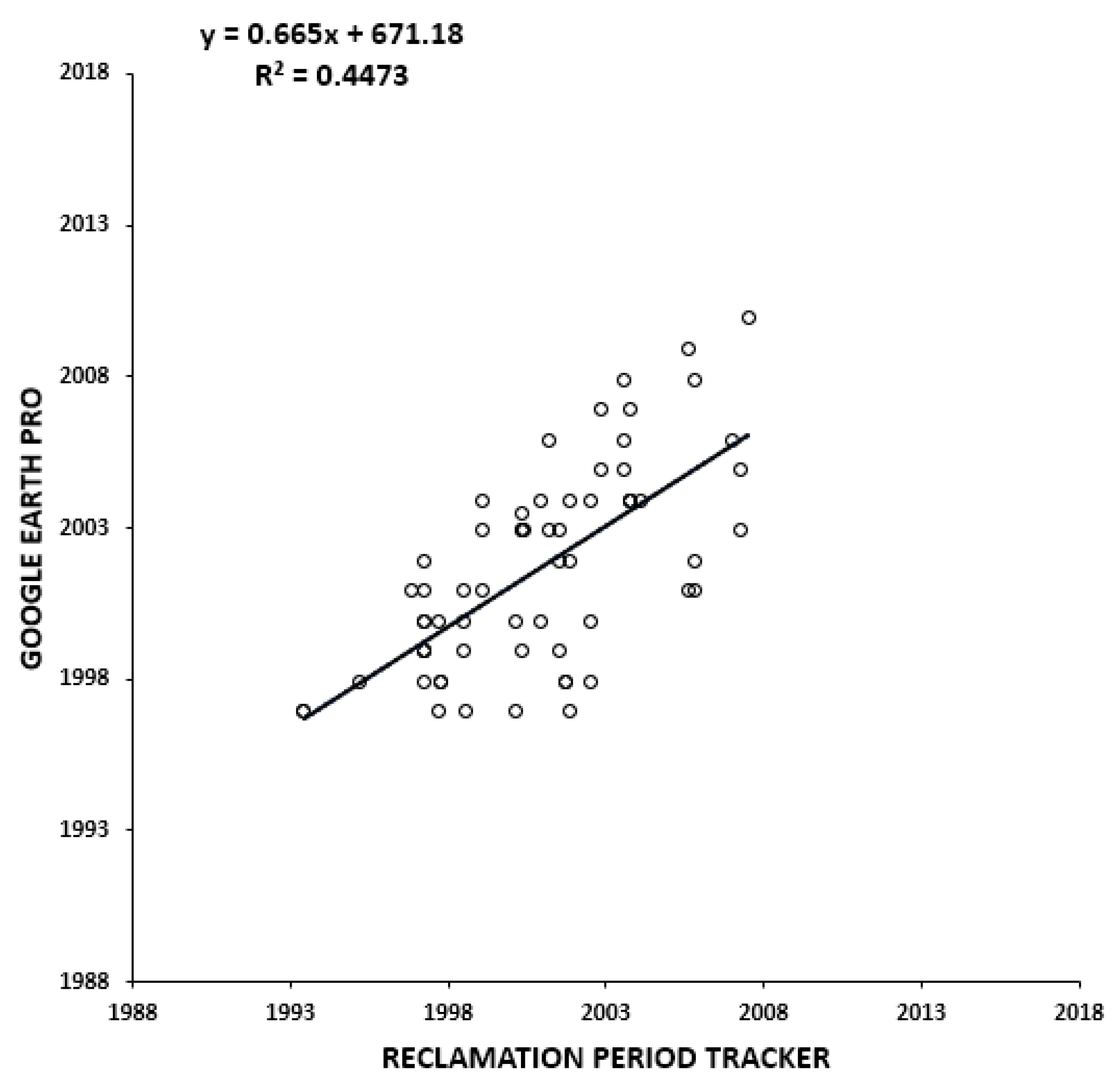
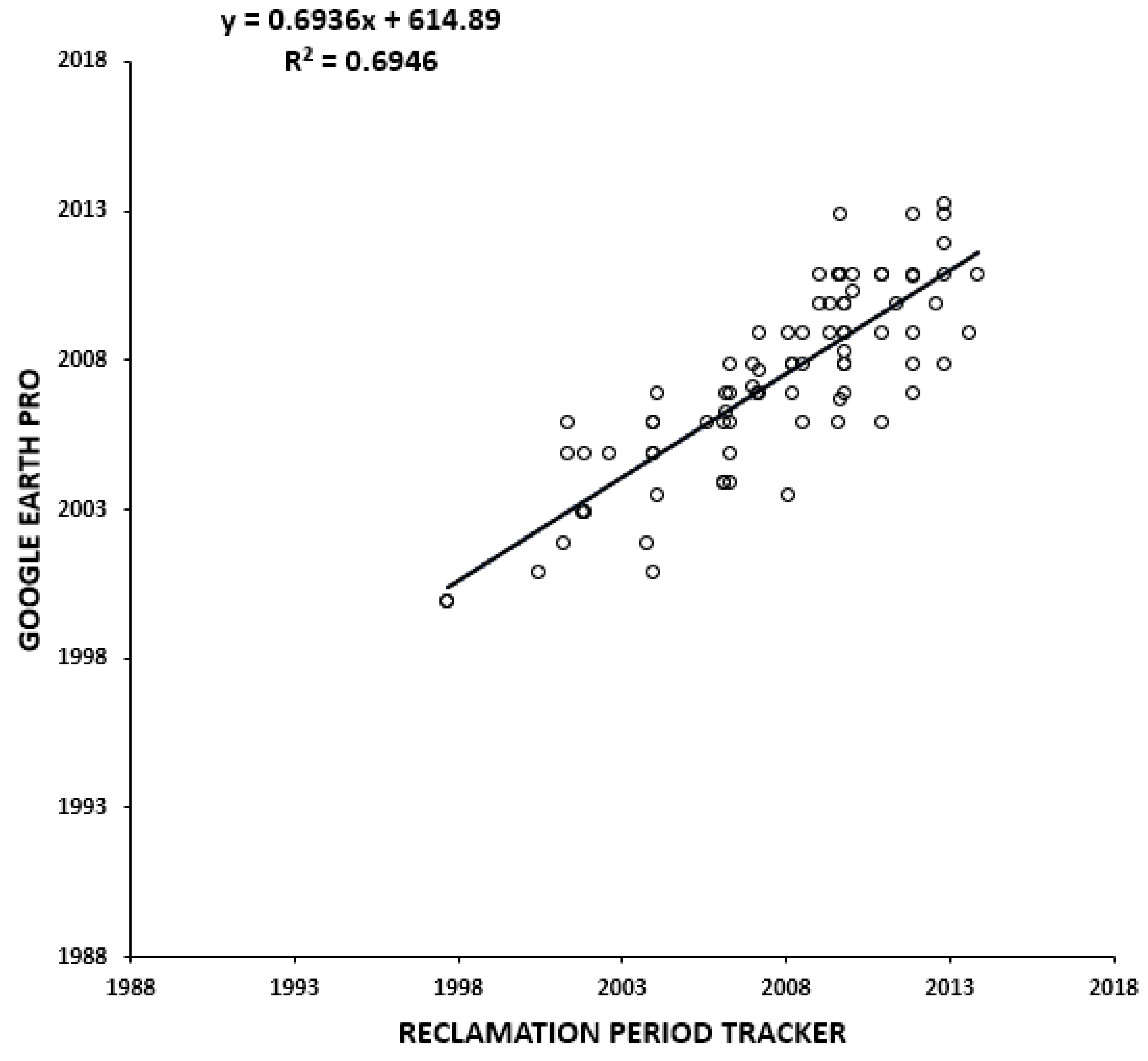
| Type of Data | Amount of Observations | Date of Observation (Year) |
|---|---|---|
| Landsat-5 TM | 66 | 1988–2009 |
| Landsat-7 ETM+ | 28 | 2000–2012 |
| Landsat-8 OLI | 14 | 2013–2018 |
| Result | Correct | Incorrect | Total | |
|---|---|---|---|---|
| Class | ||||
| Water | 60 | 1 | 61 | |
| Non-water | 140 | 3 | 143 | |
| SEDIMENT | 33 | 3 | 36 | |
| Total | 233 | 7 | 240 | |
| Water | Ground | Urban | Vegetation | Farmland | Total | ||
|---|---|---|---|---|---|---|---|
| Classification | |||||||
| Water | 44 | 1 | 2 | 3 | 50 | ||
| Ground | 1 | 17 | 2 | 20 | |||
| Urban | 0 | 0 | |||||
| Vegetation | 5 | 5 | 10 | ||||
| Farmland | 4 | 16 | 20 | ||||
| Total | 45 | 18 | 0 | 11 | 26 | 100 | |
| Water | Non-Water | Total | ||
|---|---|---|---|---|
| Tracker | ||||
| Water | 44 | 6 | 50 | |
| Non-water | 1 | 49 | 50 | |
| Total | 45 | 55 | 100 | |
| Time Difference (Month) | Start Time | End Time |
|---|---|---|
| Less than 36 months | 42 | 72 |
| 36–60 months | 22 | 11 |
| More than 60 months | 33 | 15 |
| Total | 98 | 99 |
Publisher’s Note: MDPI stays neutral with regard to jurisdictional claims in published maps and institutional affiliations. |
© 2022 by the authors. Licensee MDPI, Basel, Switzerland. This article is an open access article distributed under the terms and conditions of the Creative Commons Attribution (CC BY) license (https://creativecommons.org/licenses/by/4.0/).
Share and Cite
Shi, Y.; Huang, C.; Shi, S.; Gong, J. Tracking of Land Reclamation Activities Using Landsat Observations—An Example in Shanghai and Hangzhou Bay. Remote Sens. 2022, 14, 464. https://doi.org/10.3390/rs14030464
Shi Y, Huang C, Shi S, Gong J. Tracking of Land Reclamation Activities Using Landsat Observations—An Example in Shanghai and Hangzhou Bay. Remote Sensing. 2022; 14(3):464. https://doi.org/10.3390/rs14030464
Chicago/Turabian StyleShi, Yuming, Chengquan Huang, Shuo Shi, and Jianya Gong. 2022. "Tracking of Land Reclamation Activities Using Landsat Observations—An Example in Shanghai and Hangzhou Bay" Remote Sensing 14, no. 3: 464. https://doi.org/10.3390/rs14030464
APA StyleShi, Y., Huang, C., Shi, S., & Gong, J. (2022). Tracking of Land Reclamation Activities Using Landsat Observations—An Example in Shanghai and Hangzhou Bay. Remote Sensing, 14(3), 464. https://doi.org/10.3390/rs14030464






